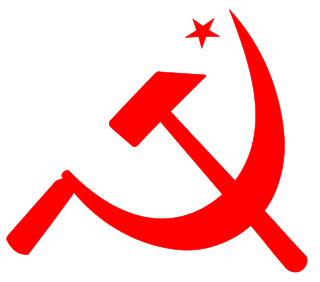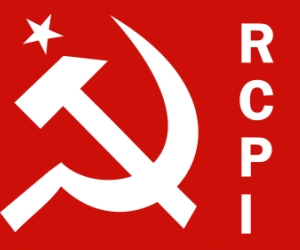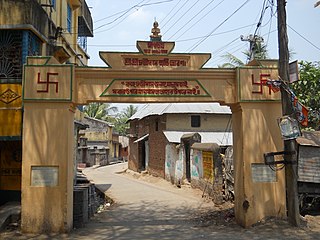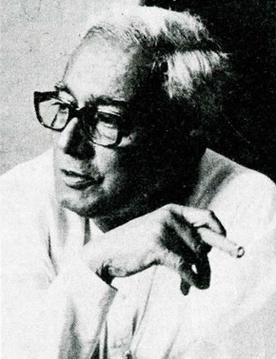
The Communist Party of India (Marxist) (abbreviated as CPI(M)/CPIM/CPM) is a communist political party in India. It is the largest communist party in India in terms of membership and electoral seats, and one of the national parties of India. The party was founded through a splitting from CPI in 1964 and it quickly became the dominant fraction.

Ānanda Mārga, or officially Ānanda Mārga Pracāraka Saṃgha, is a world-wide socio-spiritual organisation founded in Jamalpur, Munger, Bihar, India, in 1955 by Prabhat Ranjan Sarkar, known as Shrii Shrii Anandamurti. It is also the name of the philosophy and life-style propounded by Sarkar, described as a practical means of personal development and the transformation of society. It is established in more than 180 countries across the world. Its motto is Ātmamokśārthaṃ jagaddhitāya ca.
Events in the year 1982 in the Republic of India.

The Revolutionary Communist Party of India is a political party in India. The party was founded as the Communist League by Saumyendranath Tagore in 1934, breaking away from the Communist Party of India (CPI). RCPI led armed uprisings after the independence of India, but later shifted to parliamentary politics. The party is active in the Kerala, West Bengal and Assam. The party was represented in the West Bengal while being a part of Second United Front Cabinet (1969) as well as in various state government during the Left Front rule in the state (1977–2011). In Assam, the party won four Legislative Assembly seats in 1978, but its political influence has since declined in the state.

Kasba is an upscale and standard locality of South Kolkata, in Kolkata district, West Bengal, India. It is situated in the southern part of the city encircled by the Sealdah South section of the Eastern Railways to the west, Dhakuria and Haltu to the south, the Eastern Metropolitan Bypass to the east and the locality of Tiljala to the north.
The Purulia arms drop happened on 17 December 1995 when unauthorised arms were dropped from an Antonov An-26 aircraft in Purulia district in the Indian state of West Bengal. The chief accused "Kim Davy" has been vocal about his involvement in the arms drop. He asserts he tried to procure arms to protect members of Ananda Marga from communists and claims that it was a conspiracy of the Congress Indian government together with R&AW and MI5 to overthrow the communist government in West Bengal and he was given assurances from the central government about his safety and return to Denmark. He further alleges that MP Pappu Yadav, in association with the then Prime Minister of India P. V. Narasimha Rao facilitated his safe exit from India. Niels Holck is author of the book De kalder mig terrorist. Niels Holck was involved in a 14-year journey from 1982 involved in community building projects like building schools in Guatemala, agricultural projects in Ananda Nagar, Purulia, India and attending tiger conferences in Russia. According to Holck, the Government of India at the time permitted arms drop operation for Ananda Marga to be able to protect its projects and people from the onslaught of Communists in Bengal. The Communists in Bengal had been targeting and killing people involved with Ananda Marga projects right from the 1970s, and this continued well into the 1990s.
The Marad massacres were two incidences of religious violence that occurred in 2002 and 2003 at Marad Beach in Kerala, India. The 2002 incident led to five deaths; three Hindus and two Muslims were killed when scuffles that began as a trivial altercation over drinking water at a public tap became violent. Out of 393 people arrested, 62 were members of Indian Union Muslim League convicted for life imprisonment.
Mohammed Salim is an Indian politician belonging to the Communist Party of India (Marxist). He was inducted in the politburo of CPI(M) in the 21st party congress organised at Visakhapatnam in 2015. He was a member of the 16th Lok Sabha, representing Raiganj constituency. Earlier, he was a member of the 14th Lok Sabha, representing the Calcutta North East constituency of West Bengal. After delimitation, in the 2009 Lok Sabha election Salim contested the new Calcutta North constituency, and lost to Sudip Bandyopadhyay of the Trinamool Congress.

Nanoor, is a village in Nanoor CD block in Bolpur subdivision of Birbhum district in West Bengal. Nanoor is the birthplace of 14th century lyric poet Chandidas of Vaishnava Padavali fame. It is developing as a craft centre with NGO support. With the massacres in 2000, Nanoor was in intense media focus.
Nanoor massacre refers to the massacre of eleven landless labourers allegedly by CPI(M) activists in Suchpur, near Nanoor and under Nanoor police station, in Birbhum district in the Indian state of West Bengal, on July 27, 2000.

The Sainbari Murder occurred on March 17 1970, in the house of the Sain family in Bardhaman, West Bengal, India, where three people were killed and their blood was forced to be eaten with rice by their mother. Later, it was mentioned as one of the most notorious murder incidents in India.
Cossipur Assembly constituency was a Legislative Assembly constituency of Kolkata district in the Indian state of West Bengal.
On 30 May 1990, three health officers, two from the Health Department of the Government of West Bengal and one from UNICEF, were raped by a group of alleged CPI (M) supporters, in Bantala Road, when they were returning from Rangabelia village in Gosaba. One of the officers and their driver died while resisting the attackers.

The Politburo or Polit Bureau is the highest body of the Communist Party of India (Marxist). The members of the Politburo are elected by the Central Committee in the immediate aftermath of a National Party Congress, which is held every three years.
The Left Front is an alliance of left-wing political parties in the Indian state of West Bengal. It was formed in January 1977, the founding parties being the Communist Party of India (Marxist), All India Forward Bloc, the Revolutionary Socialist Party, the Marxist Forward Bloc, the Revolutionary Communist Party of India and the Biplabi Bangla Congress. Other parties joined in later years, most notably the Communist Party of India.

Legislative Assembly elections were held in the Indian state of West Bengal in 1982. The Left Front, which had won the 1977 West Bengal Legislative Assembly election, emerged victoriously. The Indian National Congress emerged as the main opposition party in the state, as the Janata Party was disintegrating.

Promode Dasgupta was an Indian Communist politician from West Bengal, often referred to as PDG. He was the first leader of the West Bengal unit of the Communist Party of India (Marxist), serving as State Secretary from the party's birth in 1964 until his death in 1982. He was also a member of the CPI(M)'s politburo, its supreme decision-making body. Although he personally never contested an election, Dasgupta earned a reputation as a disciplined organiser of the party and its cadres. Under his leadership, the CPI(M)-led Left Front came to power in a landslide victory in the 1977 election, and remained the dominant force in West Bengal politics for several decades following Dasgupta's death.

In 1964, a major split occurred in the Communist Party of India. The split was the culmination of decades of tensions and factional infighting. When India became independent in 1947, differences arose of how to adapt to the new situation. As relations between the Nehru government and the Soviet Union improved, a faction that sought cooperation with the dominant Indian National Congress emerged within CPI. This tendency was led by S.A. Dange, whose role in the party hierarchy became increasingly controversial. When the Sino-Indian War broke out in 1962 Dange's opponents within CPI were jailed, but when they were released they sought to challenge his leadership. In 1964 the party was finally divided into two, with the left faction forming the Communist Party of India (Marxist). The split had a lot of regional variations. It also impacted other organizations, such as trade union and peasant movements. The split has been studied extensively by scholars, who have sought to analyze the various domestic and international factors involved.
Bijon Setu is a bridge situated above Ballygunge Junction railway station connects EM Bypass through Kasba with Gariahat.
Sachin Sen was an Indian politician belonging to the Communist Party of India (Marxist). He was a member of the West Bengal Legislative Assembly from Ballygunge constituency (1977–1992), and served as Chief Government Whip from 1989 to 1991.








